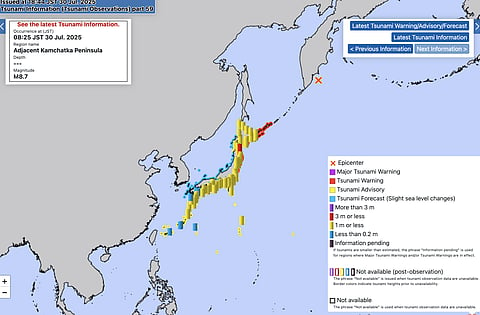Russia Earthquake Sparks Pacific Tsunami Scare, Underscores Urgency of Global Early Warning Systems
A Massive Quake Triggers Regional Alarm
On 29 July 2025, a massive magnitude 8.8 earthquake struck off the Kamchatka Peninsula in the Russian Federation, unleashing a tsunami threat that rippled across the Pacific Basin. Millions of people were ordered to evacuate in Russia, Japan, and parts of the United States, including Hawaii.
The event once again underscores the critical importance of multi-hazard early warning systems—not just for earthquakes and tsunamis, but for cascading risks that can follow natural hazards.
The World Meteorological Organization (WMO), in coordination with the UNESCO Intergovernmental Oceanographic Commission (IOC) and the UN Office for Disaster Risk Reduction (UNDRR), is closely monitoring the situation and supporting global coordination through its Global Telecommunication System and Information System.
"Tsunamis Strike With Little Warning"
“Tsunamis strike with little warning and immense force,” said WMO Secretary-General Celeste Saulo. “Multi-hazard early warning systems—backed by risk knowledge, rapid forecasts, and clear communication—are not optional; they are life-saving. We have made great strides in the past 20 years, but we can do even more.”
The shock of the recent quake has reinvigorated calls for stronger international cooperation to prevent natural hazards from becoming human tragedies.
Wave of Warnings: Tsunami Alerts Across the Pacific
The undersea earthquake triggered tsunami warnings issued by both the Japan Meteorological Agency (JMA) and the US NOAA Tsunami Warning Center. These alerts were rapidly disseminated across the Pacific, setting into motion mass evacuations and readiness protocols in multiple countries.
Tsunamis—typically caused by powerful underwater earthquakes—travel at the speed of a jetliner, and when approaching coastlines, can grow in height and energy, striking with devastating impact. While less frequent, undersea volcanic eruptions or coastal landslides can also generate these destructive waves.
A History of Lessons: Progress and Gaps in Early Warning
Two recent historical events highlight both the value and limitations of tsunami early warning systems:
2011 Japan Earthquake & Tsunami: A magnitude 9.0 quake unleashed a catastrophic tsunami, killing over 18,000 people and leading to the Fukushima nuclear disaster. Despite the tragedy, the JMA’s rapid alerts and global tsunami systems minimized the loss where warnings were heeded—showcasing the effectiveness of robust early warning infrastructure.
2018 Sulawesi Earthquake, Indonesia: A magnitude 7.5 quake triggered a localized tsunami in Palu Bay, exacerbated by submarine landslides. The event exposed weaknesses in local detection and communication systems, especially for near-field tsunami events, where response windows are extremely short.
These contrasting cases reaffirm the need for end-to-end systems that ensure real-time detection, rapid dissemination, and community-level preparedness.
Global Cooperation: Strengthening the Tsunami Warning Architecture
Since the devastating 2004 Indian Ocean tsunami that killed 230,000 people, international cooperation on tsunami risk reduction has expanded significantly. The UNESCO/IOC now coordinates tsunami warnings worldwide through regional Intergovernmental Coordination Groups (ICGs).
The WMO plays a pivotal role in this network, partnering with IOC through the Tsunami and Other Sea-Level Related Warning and Mitigation Systems Working Group (TOWS-WG). The aim is to enhance coordination between Tsunami Warning Centres and National Meteorological and Hydrological Services (NMHSs).
Globally, over 35% of National Tsunami Warning Centres are operated by NMHSs. In some regions, this figure reaches 80%, underscoring the central role of meteorological services in tsunami preparedness. The WMO continues to build NMHS capacities so warnings are not only timely, but also clear and actionable for communities at risk.
Ocean Decade and Future Preparedness
The ongoing UN Ocean Decade includes a Tsunami Programme aimed at:
Strengthening observational networks
Enhancing data-sharing protocols
Promoting impact-based forecasting
Accelerating capacity-building efforts
Supporting regional collaboration
Emerging technologies and real-time modeling are helping refine warning systems, but broader public education, infrastructure resilience, and governance frameworks must keep pace with risk.
Conclusion: From Warning to Action, Collaboration is Key
The powerful quake off Russia’s eastern coastline serves as a sharp reminder that nature does not wait. With sea-level threats accelerating and tectonic activity an ever-present risk in the Pacific Ring of Fire, the global community must continue to invest in multi-hazard early warning systems that integrate science, policy, and local action.
As Celeste Saulo rightly stated, “We have made great strides… but we can do even more.” In an era where cascading hazards are becoming the norm, preparedness is no longer a choice—it is a collective responsibility.


